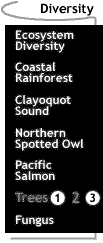Diversity: Trees
Old Growth There is
no agreed-upon definition of the term 'old growth.' In spite of the
thousands of times it has appeared in print and other media, this term has not always
meant the same thing to all authors.Kathie Durbin offers the
following set of characteristics that indicate an old growth forest. Her description was
published by the National Forest Service's Pacific Northwest Forest and Range Experiment
Station in 1981.
[There are] four key structural characteristics of old growth: large, live trees 175 to
750 years of age and even older; standing dead trees called snags; logs fallen to the
forest floor; and logs lying in streams. © 1996. Durbin, K. Oregon.
In R. Kirk (Ed.), The Enduring Forests. Seattle: The Mountaineers, p. 62.
You may want to see another set of criteria for
recognizing a temperate rain forest and learn more about the climate of the Olympic
National Park of Washington.
The Douglas Fir
Douglas-fir, our most famous tree, thrives throughout the mountainous far west from
Central British Columbia into Mexico and from the Pacific Ocean east as far as Colorado.
Close relatives live in California, Mexico, China, Taiwan, and Japan. The trees can be
very old and, on the coast, very large. Reliable statistics are not nearly so dramatic as
those in folklore and fuzzy memories, but even careful figures indicate that Douglas-fir
often live 750 years and the oldest may reach 1,300 years of age, with heights reaching
315 feet and trunk diameters as great as 14 feet. © 1996. Edwards,
Y. British Columbia. In R. Kirk (Ed.), The Enduring Forests. Seattle: The
Mountaineers, p. 116.
Understanding What Old Growth Is
Old-growth Douglas-fir like that of the central Cascades, if lost, will not regrow to this
stage within the lifetime of our great, great, great, great, great, great, great
grandchildren. © 1996. Durbin, K. Oregon. In R. Kirk (Ed.), The
Enduring Forests. Seattle: The Mountaineers, p. 61.
Microclimates in the Forest Microclimates are climatic pockets where conditions differ from the overall
climate of a larger surrounding area. Microclimates often occur where there is a special
"lay of the land" or a distinctive vegetative cover. Left: Large cedars in the Hoh Rainforest of
Washington. Photo: Ed Shay
 Left: Large
redwoods in
Henry Cowell Redwoods State Park. The person stands 5'11" tall. Photo: Courtesy of Stephanie Stockman Left: Large
redwoods in
Henry Cowell Redwoods State Park. The person stands 5'11" tall. Photo: Courtesy of Stephanie Stockman
Tall trees become winners; sunlight is strongest at the top of the forest, and by using
its energy trees are the most successful earthbound invaders of the atmosphere. They
create their own climate, quite different from that outside the forest. They cool warm
air, tame winds, and pump water from the soil. They hold winter snowfalls aloft to be
melted, delay the spring melting of accumulated snow on the forest floor, and turn fogs
into local rain. © 1996. Edwards, Y. British
Columbia. In R. Kirk (Ed.), The Enduring Forests. Seattle: The Mountaineers, p.
110.
Elevation and Latitude Affect Plant Life
Ecologists no longer use his (C. Hart Merriam) terminology, but the pattern he first
called attention to remains: vegetation varies with both elevation and latitude. This
phenomena is now expressed in the concept of zones, which are defined locally for each
region or mountain complex. © 1996. Sawyer, J. O., Jr. Northern
California. In R. Kirk (Ed.), The Enduring Forests. Seattle: The Mountaineers, p.
38.
[ Diversity: Ecosystem Diversity / Coastal Rainforest /
Clayoquot Sound / Northern
Spotted Owl /
Pacific Salmon / Trees: page 1 / page 2 / page 3 / Fungus ]
[ Ecosystem Flexibility ] [ Natural & Human Disturbance ] [ Logging ]
[ Tree Farming ] [ Precipitation
& Water Supply ] [ Researchers
]
[ Glossary
] [ Related Links
]
[ References
] [ PBL Model
]
[ Home
] [ Teacher
Pages ] [ Modules
& Activities ]
|



